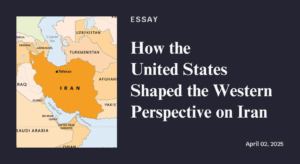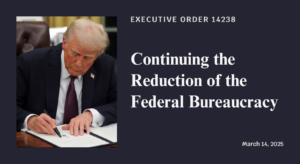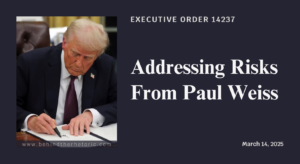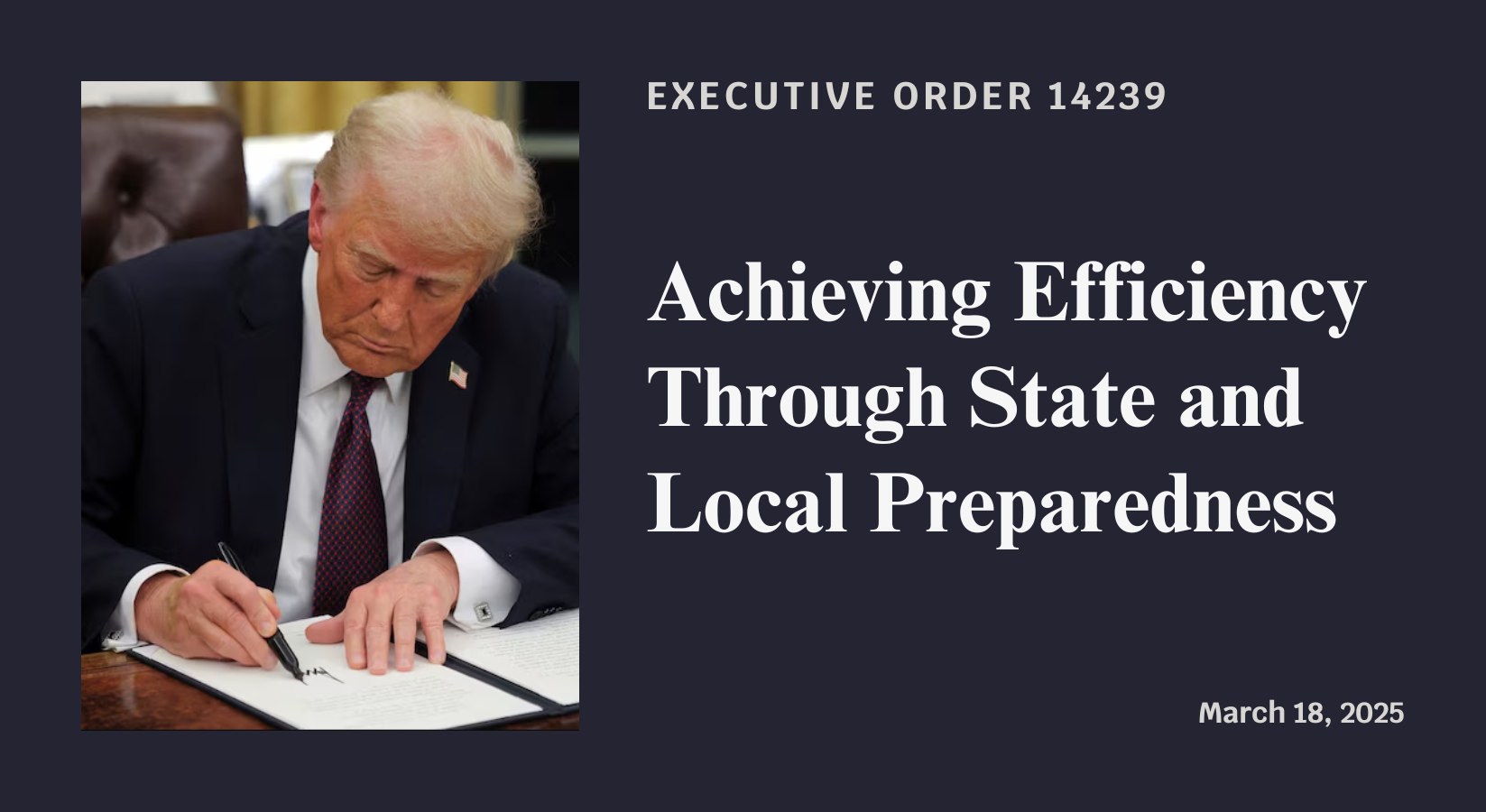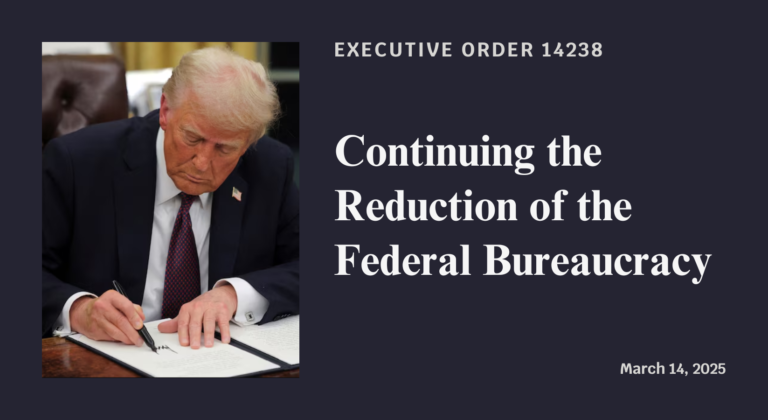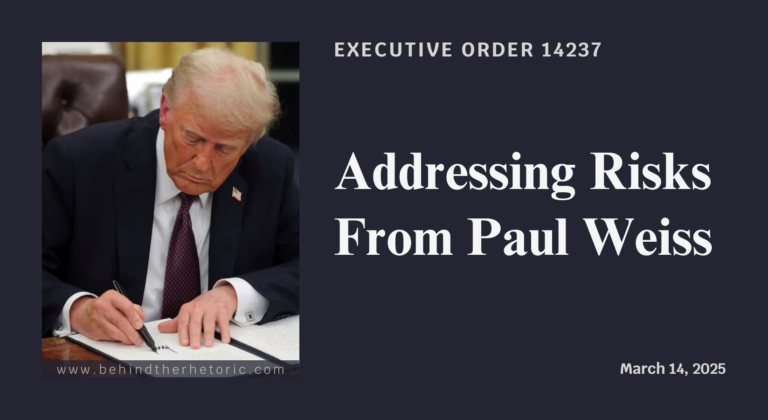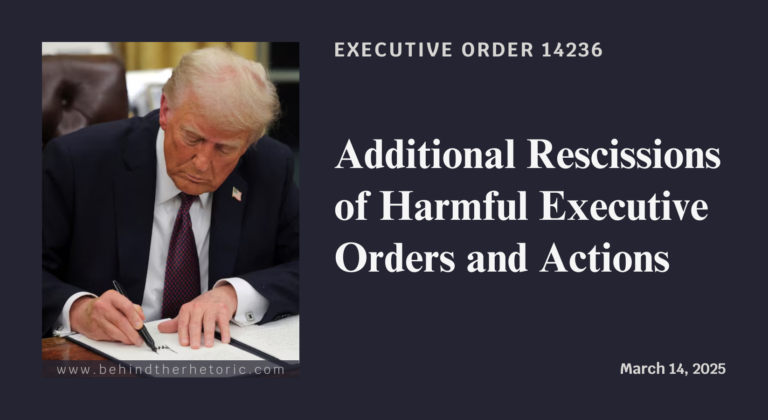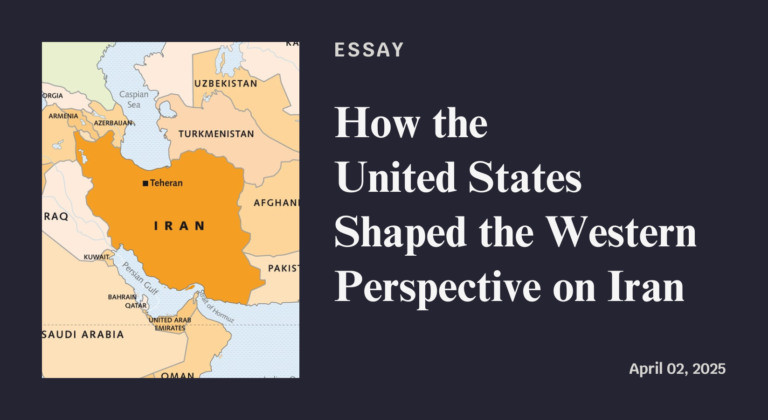Executive Order 14239
Achieving Efficiency Through State and Local Preparedness
Signed on March 18, 2025
On March 18, 2025, President Trump signed Executive Order 14239, which shifts national preparedness responsibilities to state and local governments while reducing the federal role in disaster management and infrastructure resilience. This order mandates the creation of a National Resilience Strategy, updates policies governing critical infrastructure, and restructures federal preparedness and response frameworks. It also establishes a National Risk Register to assess threats and redefine national preparedness functions.
🔗 Read the Executive Order on the Federal Register
🔗 Read the White House Announcement
What You Should Know
This order shifts disaster preparedness responsibilities away from the federal government.
The order places greater responsibility on state and local governments to prepare for disasters, such as cyberattacks, wildfires, hurricanes, and space weather. While decentralization can improve localized response efforts, it also removes federal oversight and funding, leaving states with widely varying levels of preparedness. Many states lack the resources to handle large-scale emergencies, meaning underfunded and disaster-prone areas will face greater risks without adequate federal support.
A new National Resilience Strategy will be developed—but lacks clear funding commitments.
The administration is requiring a National Resilience Strategy within 90 days to outline priorities for national preparedness. However, the order does not allocate new federal funding to assist states in implementing these strategies. Without dedicated federal resources, this shift could leave states struggling to finance essential infrastructure and emergency preparedness measures, leading to increased regional disparities in disaster response.
Federal disaster management policies will be overhauled, potentially reducing national coordination.
The order directs a review and revision of policies related to critical infrastructure security, national continuity planning, and federal emergency response. By replacing the “all-hazards approach” with a “risk-informed” strategy, it may limit federal involvement in emergencies that are deemed a lower risk on paper but have devastating impacts in practice. The de-prioritization of federal disaster aid could leave vulnerable communities without sufficient support when disasters strike.
Climate-related threats are downplayed in this policy shift.
Although the order acknowledges threats like wildfires and hurricanes, it does not explicitly address climate change as a key driver of these disasters. Instead, it reframes disaster preparedness as a state-led initiative, omitting federal accountability for addressing climate resilience and infrastructure adaptation. This could weaken national efforts to mitigate climate-related disasters, leaving states to manage long-term environmental threats on their own.
Critical infrastructure policies will be revised, but federal oversight is being reduced.
The order mandates a review of national critical infrastructure policies, including those related to food security, supply chains, and emergency preparedness. However, it explicitly excludes any consideration of misinformation, disinformation, or “cognitive infrastructure,” which previous policies recognized as national security threats. This signals a move away from federal oversight in key areas like cybersecurity and information integrity, potentially making infrastructure systems more vulnerable to attacks and failures.
Who Wins?
State governments with strong infrastructure funding
States that already have robust disaster preparedness programs and financial resources will benefit from this order. Wealthier states with established emergency response systems will have more control over their preparedness strategies, while less-resourced states may struggle with increased responsibilities without additional federal funding.
Private contractors and corporations in the disaster response industry
With states and local governments expected to take on a greater role in preparedness, private companies providing emergency management services, infrastructure resilience consulting, and disaster recovery solutions will see increased demand for their services. This could lead to more privatized disaster response efforts, benefiting companies that secure state and local contracts.
Opponents of federal disaster relief programs
Conservative policymakers and think tanks that advocate for reducing federal disaster aid and shifting responsibilities to state governments will see this order as a victory. By limiting federal involvement, this order aligns with broader efforts to shrink the federal role in emergency management and shift financial burdens to states.
Who Loses?
Disaster-prone states and underfunded communities
States that face frequent natural disasters—such as those in hurricane-prone coastal regions or wildfire-prone areas—will have fewer federal resources to rely on. Without strong state-level funding, communities in these regions could be left with inadequate disaster response capabilities, increasing their vulnerability to large-scale emergencies.
Low-income and marginalized communities
Communities that rely on federal disaster aid for recovery will be disproportionately impacted. Historically, wealthier areas receive more state funding for infrastructure and preparedness, while lower-income communities depend on federal assistance. By reducing federal oversight and funding, this order will exacerbate existing inequalities in disaster response and recovery efforts.
Climate scientists and policy advocates
This order significantly downplays climate change as a contributing factor to national disaster preparedness. By removing federal leadership on climate resilience, it undermines national strategies for addressing climate-driven disasters. Climate scientists and policy experts advocating for comprehensive resilience strategies will face an uphill battle as state-level policies become more fragmented.
Executive Order 14239 represents a major shift in U.S. disaster preparedness, placing the burden on state and local governments while scaling back federal oversight and funding. While decentralization can lead to more tailored responses, it risks creating significant disparities in preparedness, leaving underfunded states and vulnerable communities at greater risk. By prioritizing a state-driven approach without clear funding commitments, this order weakens national coordination in disaster management and downplays climate-related threats.
Without strong federal leadership and dedicated funding, many communities will struggle to maintain the level of preparedness needed to address increasingly severe and frequent disasters. The effectiveness of this order will depend on how well states can adapt and whether the federal government continues to provide support when it matters most.
Take Action
Contact your state and local representatives to demand increased preparedness funding
With the federal government stepping back from its role in disaster preparedness, it’s critical to push state lawmakers to allocate sufficient resources to emergency management, infrastructure resilience, and climate adaptation initiatives.
Support organizations advocating for disaster relief and climate resilience
Groups working on climate resilience, disaster response, and infrastructure adaptation will play a crucial role in addressing the gaps created by this policy shift. Consider supporting or volunteering with organizations that provide disaster relief and advocate for stronger preparedness policies.
Stay informed and push back against misinformation about disaster response policies
Many narratives surrounding this order will frame it as an improvement in efficiency, but the reality is that it shifts financial burdens to states without ensuring they have the necessary resources. Educating yourself and others on the consequences of this policy will help hold leaders accountable for their decisions.
Disaster preparedness should not be a partisan issue, nor should it be left to chance based on a state’s financial standing. Policies that reduce federal support and oversight put communities at greater risk, especially those already facing systemic inequalities. Staying informed, advocating for responsible disaster management, and holding officials accountable is key to ensuring that preparedness remains a national priority.
